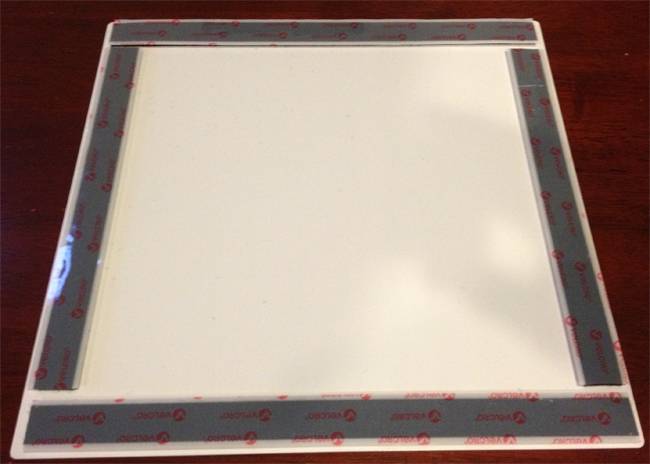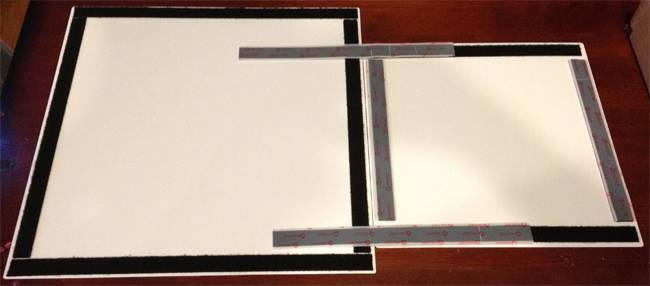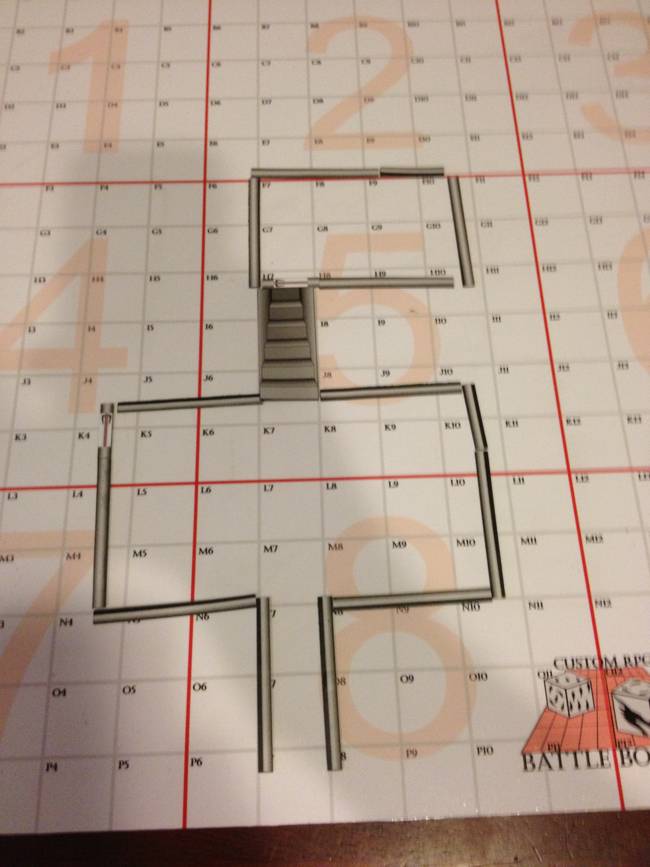Battle Boards, a product that just launched on Kickstarter, are magnetic, dry-erase battle grids that can be combined using velcro strips. (They have no connection to Battlegraph Dry Erase Tiles, aka Battle Boards, which we reviewed here back in 2009.)
Although we’ve reviewed products like this before on the Stew — Battlegraph Dry Erase Tiles, noted above, as well as Tact-Tiles in 2006 and Automagic Tiles just last month — Battle Boards don’t fall into quite the same category as those products. Yes, they’re modular in the sense that you can stick two of them next to each other, and yes, they’re dry-erase, but they don’t fit together like puzzle pieces and they’re made of metal.
My review set includes one tile that is final (a production item) and one that is “next-to-latest generation,” but looks very close to final to me. I also received some adhesive magnets and prototype magnetic dungeon features. My review package (which was free) came with a letter from Aaron Renfroe, the creator of Battle Boards, detailing what stage of the production process each item was from.
My experience with dry-erase map tiles
I used my set of Tact-Tiles in several short games as a GM, and then in at least one campaign lasting more than a year as a player; I still have that set (they’re built to last). I logged dozens and dozens of hours of play time using them over the course of a few years. They rock.
Battlegraph tiles I’ve only used as a player, but we used them in virtually every session of two D&D 3.x campaigns played weekly over the course of about two years. I liked them a hair less than Tact-Tiles, mainly because the grooves tended to collect dry-erase dust and I found the white surface a bit too stark compared to Tact-Tiles’ gray plastic. The first problem was minor and the second was purely a matter of personal preference; Battlegraph tiles were also a great product.
I reviewed Automagic Tiles but have never used them in actual play, and I wouldn’t use the set I was sent. The pre-release version I reviewed has promise, but it’s not a good product in the form I saw it in.
The scoop on Battle Boards
So what sets Battle Boards apart?
- They’re made of steel, 1/32″ thick, with a dry-erase surface
- They come in two sizes, 12″ (Standard) and 16″ (EX), and two grid patterns: “strategic” and “roleplay”; all cells are labelled
- Magnets will stick to them, so you can use magnetized miniatures
- Between the steel and the dry-erase coating is a “skin” that can be applied during production, allowing for different patterns and the like
- Using velcro, you can stick boards together edge to edge to form a larger surface
With the caveat that Kickstarter pricing can’t be considered “real pricing,” the standard boards are $45 and the EX boards are $55.
There’s also a table-sized version, the aptly-named Battle Table, which is the same as the Boards apart from its size: 2’x4′. There are a ton of options spelled out in the Kickstarter that I won’t get into here — I’m only going to review what came in my package.
What are they like?
They’re beasts! Being steel, they’re heavy for their size and they feel substantial. Both sides are smooth; the undersides are coated, but not gridded. Here’s the main event, the type of board (“strategic,” with a 1″ grid) that I think most readers will be interested in. This one’s an EX, 16″ on a side.

This board is final, just like what you’d get by backing the Kickstarter.

Here’s the back:

Here’s a standard board, 12″x12″, with the “roleplay” grid:

Other than the size, the big difference here is the cell padding — the space between each cell in the grid. The cells are 1″ squares, but in a 10×10 grid — not 12×12, as they would be with the “strategic” pattern.

Personally if I’m going to buy a gridded board, I want a 1″ grid with no cell padding. I don’t have a use for this style of board, but you might. In any case, it’s nicely made, just like the other one.
Here’s the back of the standard board, which has the hook half of the velcro strips attached to the soft half on all sides:


From the back side:



In both cases, the misalignment doesn’t cause a problem. You’d have to be looking pretty closely to even notice it, and the gap is so small that I’m not worried about drawing on it when using these boards.
Last but not least, let’s look at the magnets. My review bundle came with a pile of little dungeon walls and stairs and so forth:


My package also included a handful of magnetic disks, one side of which is sticky. They’re not described as prototypes, so I assume they’re final.


Along with their durability and the option to apply artwork or a colored background under the dry-erase surface, this is one of the big differentiators for these tiles. The Kickstarter page points out that if you magnetize your minis (and use their magnetic walls, if you go that route), you can leave your tiles out between sessions and everything should be right where you left it the next time you play.
That’s neat, but honestly it’s not a feature I’ve ever needed. Battles, especially in RPGs that use tactical grids, tend to get finished in one session even if it means staying up way too late. Similarly, I’ve never had issues with bumping minis out of position while playing, another problem magnetized minis solve.
But that’s me: You might pause mid-battle, have cats who like to prowl around your maps, or otherwise get great mileage out of the magnetic aspect of Battle Boards.
The takeaway
Battle Boards are well-made, well thought-out, and a quality product overall. They look like they’ll last for years, the dry-erase surface works as it should, and I like the combination of numbered grid cells and numbered “sectors.” The velcro is a good addition. Even if you only have one tile, with no need for the velcro, it will still protect your table.
For my money, the EX tile — which doesn’t sound that much bigger, but is almost double the area of the standard board (an extra 112 cells; the standard is 144 total) — is the better value. For $10 more you get a lot more surface area. You could buy one EX tile and have a surface that would work for many games and situations. Two EX tiles ($95) or four standard tiles ($135) would be a nice setup for just about any game that uses a grid.
I don’t see much point to the roleplay grid, the one with the cell padding, but there’s nothing wrong with how it’s implemented. Similarly, the magnetic aspect of the boards isn’t a big plus for me — it’s a nice-to-have, not a must-have. I’ve never wished my battle maps were magnetic.
Bottom line, if you want a durable dry-erase surface that offers a decent amount of play area without taking up a lot of room, and which has some nice extra features — the numbering, the magnetic aspect, the velcro — then you should consider Battle Boards. They’re solid, attractive, and functional.
Compared to, say, a Chessex Megamat ($40, 34″x48″, gridded, wet-erase, rolled vinyl), Battle Boards are expensive for the play area you get out of them, but they offer — and combine — features that no other gaming surface I’ve seen provides.
If you’ve got questions about Battle Boards that I can answer using mine, I’d be happy to answer them in the comments below. Thanks for reading this review, and I hope it was useful to you!

















I get the idea, and Azathoth knows I’ve thought about something similar myself on occasion, but cripes, how is one supposed to transport a 16″ square piece of steel, let alone more than one? That is one awkward size and shape to accommodate in a game bag, and that’s before we talk about protecting the edges from damage or from damaging whatever else one has in the bag of crap. Then there’s the weight.
I guess there will be a special tote-bag or something. Maybe the game tool-roll lady can leap into the breach here with more needley cleverness?
For what it is worth, I think not doing a “squares one side, hexes the other” deal is a mistake with a capital mis. This feature has more than doubled the usefulness of the old Chessex battlemat (of which I have three because you need lots and not at all because I keep forgetting them when I run games heavy on the tactical griddiness and having to buy another one and I don’t want to talk about it any more).
For D20 I use the squared side, for Savage Worlds I use hexes as they are in every way more “realistic” and easier to factor into games than squares (which either require some simple Pythagorean kludging a-la D&D 3.5 or introduce what can become nerfing ranging errors a-la D&D 4.0). Hex-based tactics can be explained to a newbie in about half the time the square-based version can, and they have a more “organic” feel.
Eugh! I used the word “organic” in a sentence with no chemistry in it. Now I have to shower.
The attraction of a map that will stay put when put back in the bag and be ready to use the next game day without that map being a permanent addition to the mat (like it can be with Chessex mats) or finding critical detail just gone (any dry-erase surface) is a powerful incentive to try the idea out, though. However, it will depend on the final cost of the magnet sets and the Battle Boards themselves, I think.
I swear I edited “game tool-roll lady” to “All Rolled Up gnomes” there. Sorry, ARU gnomes.
I like the EX board but don’t really see the need for sector numbers. I don’t even see the need for numbers at all.
I’d definitely go for the standard lines for drawing rather than the thicker lines to place dungeon magnets or terrain pieces on. But that’s because I’d rather draw the lines too.
Perhaps a bit pricey, but if these boards have good durability I can see the value. Not having dry erase dust build up in grooves or holes is a big plus over the previous products I have seen.
The two uses for the numbers that I could see would be for star Fleet Battles, cloaked ships could use the sector numbers as well as the grid numbers or hidden location. Rpg could use them for invisibility spells or for tracking movement for PBEM or PbP games.